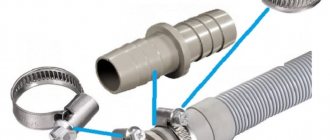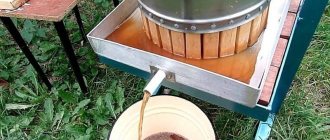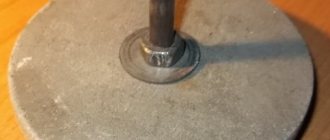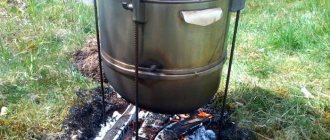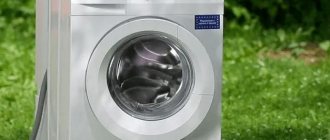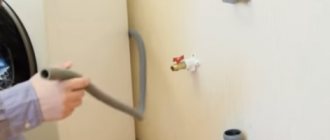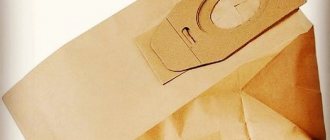DIY acoustic washing machine
Video of an acoustic washing machine:
As I wrote above, our homemade washing machine will be sonic, that is, the machine will wash thanks to sound waves.
For this we need
old speaker from speakers. The more watts in dynamics, the more clothes we can wash in one wash. That is, the calculation is based on the ratio: 1 watt of speaker per 1 kg of dirty clothes.
So, we disassemble the column and carefully remove the speaker from it. The speaker is soldered using wires to the music center. DO NOT SOLDER THE WIRES TO THE PLUG OR INSERT INTO A SOCKET.
That's all! Our design is ready. Now I'll show you how it all works.
Take a disposable plastic plate, place it on the speaker and pour water:
As you can see, sound waves are transmitted to water and replace mechanical washing by hand.
Now let's try the washing machine in action
To do this, take a plastic bucket and fill it with water. Next, put the bucket on the speaker and turn on the music.
We take dirty things that need washing (in our case, a pair of gloves), add powder or other detergent to the water and soak the gloves.
As we can see, the gloves are snow-white, so we can easily conclude that our washing machine coped with its task “excellently.”
Source
Replacing the heating element in a washing machine with your own hands
The abbreviation TEN has always stood for tubular electric heater. It’s strange when you need to replace the heating element in a washing machine with your own hands.
According to Wikipedia, Ten is a Korean surname, a village in France, the name of the most significant grunge music album of the 90s, but not an electric heater. This is also the name of the Don River.
The word heating element has gained popularity; it was used to call titans and other electric heating elements. But there is no TEN for a washing machine.
Why is a heating element needed in a washing machine?
Even a wall-mounted washing machine is connected to the water supply. This is usually done by wiring inside the supporting structure. Unlike some dishwashers, washing machines heat water on their own. This is good, because a hot riser is usually filled with liquid that is of little use for washing. Salt is dissolved in it, not intended to protect against scale, but ordinary salt.
It is added to water to prevent pipes from becoming overgrown with calcium and magnesium deposits. This water is not suitable for washing. We can wash with it, but it is important to understand that the content of impurities is high, and they can negatively affect the work.
The Internet is full of myths about why you can’t drink hot water. There are usually piles of halite near the boiler rooms. This is a coarse natural salt. Probably its presence there is not accidental, but to be added to hot water. The main purpose of salt is to prevent scale formation in the boiler. And halite coped with this task.
The second possible reason is cleaning activities that take place several times a year in any boiler room. It is not known how drinking boilers are cleaned, but industrial boilers are cleaned using hydrochloric acid and other unimaginable reagents. Of course, everything is washed afterwards, but there is no complete guarantee that it is acceptable to drink.
You should not drink hot water. And without cleaning, the efficiency of boilers decreases sharply: scale has a low thermal conductivity coefficient and interferes with the operation of heating elements. Boilers are also used for this purpose.
In them, heat transfer is carried out indirectly. The future hot water comes into contact with the primary circuit of the purified coolant, and it is already heated by fuel (fuel oil, gas, electricity). This helps reduce scale formation. Otherwise, cold water from the water intake would simply be passed through the heating elements without any manipulation.
Yes, the liquid is filtered by purification stages in the boiler room, and then passes through the chemical treatment plant, where it acquires the qualities it needs. Let us add that the consumption of excessively salty water, which is hot, at a minimum leads to severe diseases of the liver, kidneys and teeth.
It is not for nothing that cold water is constantly measured for hardness, preventing a certain limit from being exceeded.
We have already explained why hot water is not suitable for a washing machine. Let us add that in Norway it is legal to drink hot water. Dishwashers are probably made with this in mind, making a fence from the corresponding riser.
Russian realities turn out to be unsuitable for these requirements. To understand whether it is acceptable to use hot water for drinking, you need to know how it is obtained and what happens before the water enters the house. We do not think that most people are aware of such information sufficiently to competently resolve the issue.
Acoustic devices for protecting boilers from scale look good. When they are installed in all boiler rooms, hot water will become drinkable. In the meantime, it is not recommended to use it in the washing machine. Mixing type washing machines could mix cold and hot flow to obtain the temperature required for the mode.
As a result, the need for a heating element would disappear. Why, if it is possible to obtain the desired temperature by mixing water? Modes at 90 oC are generally not recommended. It is said that most powders partially lose activity above 60 oC. And the option of heating to 90 oC is completely unnecessary in reviews.
Water at a higher temperature is supplied from the hot riser.
But this is ideal, and we have already considered what happens in practice. Basically, there are two factors that prevent you from replacing the “TEN” in the washing machine with a regular mixer:
- Unsatisfactory water quality. This applies to both temperature and impurities.
- Periodic complete absence of hot water in the tap.
Regarding the first difficulty, it is recommended to create commissions and evaluate, with the drawing up of a report, the temperature. The second point has already been legally introduced in a number of cities to save money. This is official, but the real reason is unknown.
Homemade washing machine
These days it’s easy to buy a washing machine; household appliance stores offer models to suit every taste and budget. This is true, but there are situations in which buying a new device is impossible or irrational. In this case, a homemade washing machine will come to the rescue. There are several popular designs, each of which is easy to replicate.
SAMSUNG washing machines
Samsung was registered in the Republic of Korea in 1938. Initially, the brand was engaged in the production of food products (in particular, sugar), and only in 1969 it retrained as a manufacturer of household appliances.
Today, the products of the Korean brand occupy a leading position in sales of electronic equipment and consumer equipment in the world. Samsung representative offices are open in 60 countries around the world. The main factories are located in China, Korea, Thailand, and the USA.
The company pays close attention to the development of its own technologies, which ensures high quality and functionality of equipment at an affordable price.
Advantages of Samsung washing machines
- The Ecobubble™ function turns detergent into active foam through intense whisking. Powder bubbles penetrate better into fabric fibers, which guarantees effective removal of even stubborn stains and contaminants.
- Volt Control technology protects the washing machine from damage caused by unexpected power surges.
- The Jod Dial function allows you to quickly set a washing program on mechanical models with just one turn of the dial.
- QuickDrive technology provides independent movement of the rear wall of the drum, which guarantees faster working processes. The wash is completed in just 39 minutes from the start, and its efficiency remains unchanged.
- Can Balance technology: weight balls are placed in the front of the drum, which move towards the lighter weight when the structure moves. Thanks to this, the items in the machine are evenly distributed throughout the drum and washed well.
- An innovative ceramic heating element, coated with a protective layer against scale formation and corrosion, has a long service life.
- The VRT-M function reduces vibration levels, resulting in virtually silent operation of the unit.
- The high-tech inverter motor is responsible for energy efficiency, low noise levels and low water consumption. The warranty period is 10 years.
- The Diamond Drum with a relief design ensures delicate handling and maintains the original presentability and softness of things even after regular washing.
- Fuzzy Logic technology provides for automatic analysis by a “smart” control system of the weight, volume of items and type of fabric to select the optimal washing mode and duration without human intervention.
Samsung washing machine: main types
The manufacturer distinguishes 4 main lines of automatic washing machines:
- AddWash
- narrow frontal;
- full-size frontal;
- models with drying.
AddWash washing machines are equipped with an innovative additional door that can be opened during the washing process.
100% of consumers appreciated the convenience of the patented technology, thanks to which you can throw forgotten items into the unit at any time, add fabric softener, or put clothes in for rinsing or steam treatment without pre-washing. Example: WW60K42109SD with silver design, 6 kg drum capacity and 1200 rpm spin speed.
Narrow front washing machines are compact in size. The depth of the unit does not exceed 49 centimeters, which allows you to place the equipment next to the sink, in the kitchen, or in a small room. At the same time, the basic set of functions remains the same as in standard washing machines, except for the smaller drum. Example: WF 1600 W5W white, designed for 6 kg of laundry.
Full-size frontal models are available in a wide range to suit different needs. Equipped with a maximum of useful functions, they are easy to use and presentable. Example: WW90J5446FX in steel color with a spacious 9 kg drum and a power of 1400 rpm.
Models with drying are combined 2-in-1 units.
After completing the work process, the user takes out clean and dry laundry, which is immediately ready for use without additional drying.
An indispensable thing for people with an active lifestyle, residents of apartments without balconies, families with small children. Example: WD90N74LNOA/UA with an inverter motor and a depth of only 60 centimeters.
All Samsung washing machines are equipped with an accelerated mode, a delicate wash function, a laundry soak, an additional rinse, and child protection.
Why is it profitable to buy a Samsung washing machine in the ALLO online store: payment and delivery methods
The Allo store catalog presents small and large household appliances from the South Korean brand at low prices. Delivery of goods throughout the country by courier, postal and transport companies is available. We accept payment in cash, cash on delivery, non-cash (including cryptocurrency). Have a great shopping trip at Allo!
Buy Samsung washing machines in Kyiv in the ALLO.ua online store at an affordable price “as easy as shelling pears”. You need to go to the product page, read the characteristics, description and reviews - and make a purchase. Samsung washing machines are sold throughout Ukraine. Delivery in Ukraine: Zaporozhye, Dnepr, Nikolaev, Zhitomir, Kharkov, Chernivtsi, Odessa, Rivne, Poltava, Cherkassy, Kropyvnytskyi, Kherson, Ivano-Frankivsk, Vinnitsa, Kyiv and other cities of Ukraine.
Source: https://allo.ua/ru/stiralnye-mashiny/proizvoditel-samsung/
When do you need something like this?
To some, the phrase “homemade washing machine” will seem absurd, but in reality such a solution can be very useful. For example, this is a great thing for a summer house. It’s hardly worth buying a new car, knowing that for most of the year it will just sit in an empty house.
Another situation is that the automatic washing machine has broken down and is taken to the workshop. The breakdown is serious, repairs are delayed, hand washing is not an option - you can spend a few hours and assemble a simple device with your own hands. Among other things, a homemade car will be a good solution for young families forced to huddle in rented apartments.
Assembling a homemade washing machine
The most important part of the homemade product is the tank; as such, you can use a large enamel or aluminum pan; no changes will be made to its design, so at any time it can be used for its intended purpose. If you don’t have a large saucepan, you can make a homemade machine from a barrel of a suitable size.
The tank is ready, time to work on the erasing part (the cover with the motor, drive and activator installed on it). It will require a base. As such, a disk made from any sheet material available on the farm is suitable. It is better to take plastic or textolite, but you can get by with multi-layer plywood. When using wood, it is important to provide it with reliable protection from moisture. The diameter of the disk should be 10-15 cm larger than the diameter of the tank.
A hole for the shaft is drilled in the center of the disk; when using soft material, a sleeve should be pressed into it. It is recommended to use the unit from the “Skillful Hands” machine as an engine; the advantage of such a solution is that the engine does not need to be remade. If you use another unit, you will have to solve the issues of connecting the activator shaft; adapter bushings of different sizes will be required.
The motor is secured using the supplied bolts, washers and bushings; it is advisable to put a rubber gasket between it and the base; it will protect against splashes, reduce vibration, and reduce noise.
The rotating shaft must be closed, otherwise laundry will wrap around it, which is fraught with consequences. A small aluminum pan will work as a casing. A hole is drilled in its bottom. The activator sleeve is installed into it and secured from the inside with a nut. Since water will still get inside the “casing”, there is no need to use sealing collars.
The pan is attached to the disk from its lower side using self-tapping screws or bolts with nuts. The role of fastening corners will be performed by handles. As a result of all these manipulations, the following structure will be obtained: a disk, a motor is installed on top of it, its shaft passes through the base and the “casing” and is connected to the activator.
The washing machine you made with your own hands is almost ready, you just need to connect the motor to the power supply and take care of safety. For power, use a regular cable with a plug for household appliances; be sure to insulate the terminals using electrical tape or heat-shrink tubing. In addition, the engine must be closed. A cap from an old vacuum cleaner will do. To prevent the lid from “moving” during washing, shock absorbers are attached around the circumference of its lower part; plugs or rubber bushings will do.
You can start washing. Throw laundry into the tank, add water, add powder or liquid laundry soap. Close the lid and plug in the device.
Homemade manual washing machine from a bucket and plunger
The rubber part of the plunger needs some modification. Windows are cut out in it (from 3 to 6). The handle is inserted into the hole in the lid, water is poured into the bucket, laundry is placed and detergent is added. The device is easy to use - you just need to raise and lower the plunger handle, mixing the contents of the tank.
It’s good to have an automatic washing machine at hand, but sometimes you don’t have one, which means you need to use your ingenuity. With a little effort, a few hours of work, washing will become a simple and enjoyable task again.
Source
How I made a homemade washing machine from a plastic bucket and an ordinary plunger
All experienced summer residents are familiar with this situation: a mountain of dirty clothes has accumulated, but there is no way to wash it. That is, there is water, and it can be heated. But no one has the desire to wash a whole pile of laundry, as well as jeans and shorts, with their hands.
A washing machine would be a good solution. But it's not cheap. In addition, in a country house it is not always possible to connect a washing machine. However, if you activate your inventive abilities, something can be done. I present to you a unique country washing machine, two-bucket, with a mechanical drive.
For the design you will need: two plastic buckets, a lid and a regular plunger, which can be purchased at a hardware store. It is also advisable to have a drill, but you can do without a special tool. The buckets are suitable for technical purposes; factories supply them with materials for production. Such a spacious and strong container will be quite useful for the execution of our idea.
Step 1. Cut or drill holes in one of the buckets. They should be located at the bottom.
Step 2. Using a drill, make a wide puncture in the lid, preferably in the middle. You can cut it with a knife or melt it with some metal object, such as a screwdriver.
Step 3. Cut holes in the rubber part of the plunger. There can be any number of them: 2, 4 or 6.
Clearances are needed so that soapy water circulates normally, as well as for ease of use with a plunger.
The washing machine is ready. You can collect and start using.
The plunger plays the role of a piston. It is pushed into the lid with which the bucket is closed. Place dirty clothes in the container and pour hot water. If you don't have powder on hand, you can use liquid soap or shower gel.
In 10 minutes of intensive work with the piston, even heavy dirt is washed away. You can involve school-age children in this activity, as well as those who want to build up their arm muscles. The lid is needed to prevent the liquid from splashing and steaming too much. And the second bucket, with holes, will serve as a laundry basket. Washed items are placed in it to drain the soapy water.
Homemade washing machine
People living in a noisy city often go to the countryside during vacations or weekends. And such a pleasant vacation can be ruined, for example, by a broken washing machine. There is a need to return to the city several tens of kilometers away, buy a new device, and organize its delivery to the site. Not everyone knows that you can make a homemade washing machine from improvised materials. This way you will solve the problem without wasting energy on exhausting trips and money on purchasing equipment. Let's figure out how to make your own washing machine.
Wire size for washing machine
To connect the washing machine, it is recommended to lay a separate wire with a cross-section of at least 2.5 square meters. mm. It is recommended to connect the grounding wire to both the body of the washing machine and the outlet. This option will provide maximum security
Particular attention must be paid to the connection points of the wire with the automatic switch and the socket, ensuring the largest possible contact area. Increasing the wire cross-section is usually impractical
In conclusion, we note that the socket and residual current device must be in an easily accessible place for quick disconnection from the electrical network in the event of a malfunction. The photo below shows an example of installation in a panel next to the washing machine. If the apartment has a separate shield, then it is advisable to place the protection and grounding device in it, especially if there is not enough space next to the washing machine or you do not want to spoil the appearance of the walls. It should be remembered that following all the recommendations outlined in the article significantly increases your safety.
How and from what is it more profitable to make?
Trying to make things easier for yourself, the first step will be to try to fix the broken equipment. On the one hand, this is correct, but on the other hand, in most cases you will still have to organize a trip to the store to purchase replacement parts. If there was an activator washing machine of the “Malyutka” type at the dacha, then repairing it is too tedious and economically impractical.
What to do if there is no opportunity to go to the city? You can assemble a washing machine with your own hands from parts lying around in a country shed, taking some elements from worn-out equipment. Ideally, the designed product should eliminate the need for welding and turning. Assembly will take several hours.
Assembling the washing device
Before assembling the washing machine with your own hands, you need to figure out what kind of work lies ahead. It is important to understand whether you can find the necessary parts and components at your summer cottage. The design of the washer looks like this:
As a drive, you can use, for example, an electric motor from the Skillful Hands machine. Use a large enamel pan as a tank. The activator and its bushing must be removed from the failed washing machine.
You should make a device yourself that will ensure the washing process. To do this, you need to take a plastic disk, about 8 mm thick, the diameter of which will exceed the circumference of the container used as a tank by 10 cm. A hole with a diameter of 1 cm is drilled in the center of the prepared circle, into which the motor shaft will subsequently be inserted. The electric motor is secured to the disk with stator bolts; their dimensions are perfect in this case.
It is advisable to place a rubber gasket between the disc and the engine.
Afterwards you need to work on the activator. Take a saucepan of suitable size and drill a hole in its bottom. The activator sleeve is inserted there and tightened from the inside with a nut. The activator axis is placed in the bushing from the outside.
Then you need to connect the activator to the electric motor. The engine shaft at the end has a thread with a diameter of 10 mm. The standard activator is also equipped with a threaded centimeter axis. If you don’t have a ready-made bushing of similar dimensions to connect the two axles at your dacha, you can proceed as follows. Take an M10 bolt and three M10 nuts and screw them onto it. Place a steel tube of a suitable diameter on the resulting structure and roll its ends. By bending the pipe from the bolt, you will receive a reliable bushing of the desired size. The homemade bushing must be half screwed onto the electric motor shaft, and the other end onto the activator axis.
Thus, your DIY washing machine is almost ready. There is also a tank where water will be poured and laundry will be loaded, as well as a working device that starts the washing cycle. It is advisable to cover the engine, which, in fact, is outside, as an option - with part of the body from an old vacuum cleaner. The protective cover is attached using special claws.
It is important to connect the wiring to the motor correctly. The wire connections will be under the “hood”. The power cable is also recessed under the casing; only a small part of it with a plug remains outside.
To ensure that the disk is held in place when the equipment is operating, 6 caps from ordinary plastic bottles should be drilled to its bottom. This will allow the lid not to move from the center while the homemade washing machine is operating. Also, it is better to rubberize the upper part of the tank, in the example described - an enamel pan. A rubber tube is suitable for these purposes. Cut it lengthwise into 2 parts and carefully place each half on the edges around the perimeter of the container.
Stage 3. Leveling the washing machine
For proper operation of all components and assemblies of the washing machine, it is necessary that it stands on a solid and level base. The equipment should not wobble or vibrate while the drum rotates.
To dampen vibrations, you can use special anti-vibration stands, which are sold in household appliance stores as additional accessories for washing machines. You can also easily make such vibration-damping pads yourself by cutting them out of a piece of felt or rubber 3-5 mm thick.
When installing washing machines, it is very important to maintain a strictly horizontal position of the housing. When distortions occur, the wear of components increases, especially rapidly rotating ones: drum mounts, pulleys, rolling bearings
In this regard, the base on which the machine will stand must first be leveled.
Small unevenness in the floors can be leveled by turning the adjusting nut on the support legs to the right or left with a wrench. This allows you to change their height by 1-2 cm up or down.
To determine a strictly horizontal position, it is recommended to use a building level. The slope angle of the equipment ready for work should not exceed 2-3o.
How does the machine work?
The washing progress will be as follows. The laundry is placed in the tank, and washing powder or liquid detergent is poured here. Next, the items are filled with water at the required temperature.
The amount of water and clothing that the electric motor will “pull” is calculated experimentally.
The device is immersed in the tank. The plugs located on the lower surface of the disk are located around the circumference of the tank on the outside. Then you should start the engine. There is no additional need to secure the operating system in the container. The speed of the electric motor shaft will be high, this will ensure high quality laundry washing.
A significant disadvantage of a homemade washing machine in this case will be its low performance. Due to the modest power of the electric motor and the small volume of the tank, you can wash about 1 kg of dry laundry at a time, which is equivalent to, for example, five men's shirts. If you load more things, the quality of cleaning will be much worse. To increase the performance of the washing machine, you can look for a more powerful engine and increase the tank capacity.
Source
Do-it-yourself ultrasonic washing machine manufacturing technology
Anyone familiar with electrical engineering can assemble the device. The basis of any device is its circuit diagram. Having studied it, the master will be able to select the necessary components and connect them in the correct sequence. You will need the following set of elements:
| 1 | Transformerless power supply. |
| 2 | Piezoceramic emitter. |
| 3 | Pulse generator in a durable housing. |
Below is a diagram that allows such a device to work.
DD1 is an element that emits weak ultrasonic waves. The signal is amplified by four transistors. A piezoceramic emitter is connected to their outputs, which plays the role of a capacitor. It recharges at a frequency of 25 thousand Hz. The device is powered by several galvanic batteries. They will be connected in series. The quality of washing depends on the supply voltage. Even a car battery can power such a small washing machine. It is convenient to take it with you when traveling . To operate from a regular outlet, you need to install a constant voltage source between the device and the network. It should have an output voltage of no more than 15 W. It is reduced using a special transformer, a diode bridge and an electrolytic capacitor. The capacity of the latter must be at least 1000 μF.
One of the main elements of a small washing machine is the emitter. It transmits waves with a frequency of 3.5 kHz. It is connected with a cable and fixed to the board with epoxy glue. Here the remaining parts are mounted in a printed or mounted manner, and the power cord is connected.
The ultrasonic vibration generator is designed to amplify the emitter signal. Using it, a wave frequency of 28 kHz is achieved. First, the capacitance of the capacitor increases. It should be 1600 pF. If everything is connected correctly, the emitter begins to make a sound similar to a whistle. The uncomfortable tone is removed using a resistor. The device is completely immersed in water and adjusted there. When the sound disappears, the capacitance of the capacitor can be reduced to its original value of 200 pF. This is how the device operates at the fourth harmonic frequency.
From a floor lamp to a concrete mixer: new life for an old washing machine
Once upon a time, she washed out difficult stains, giving freshness and cleanliness to her favorite things. She heated the water herself, diluted the soap solution and spent hours working on trousers, blouses, tablecloths and bed linen. She worked tirelessly when a baby appeared in the house, and was an indispensable housekeeper.
But then you began to notice how she was getting old - she could no longer turn the drum quietly, as before, but did it with noise and grinding, began to let water through and, in the end, stopped forever. She was sent to the loggia to wait for the movers to arrive, but she could have done a lot more good.
And if you also store an old washing machine, you will probably find the advice of our forum members useful on how to give it a second life.
1. Grill, barbecue, smokehouse
No home or cottage is complete without cozy gatherings over barbecue. The drum of an old washing machine can make an excellent barbecue, grill, cauldron stand or home smokehouse. Thanks to the steel body, this part is not afraid of hot coals and open fire.
Materials for children's washing machine:
There are many manufacturing options, and many unnecessary little things will come in handy, in my case these are:
- carton boxes
- colander (or deep dish made of unbreakable material)
- transparencies
- button with cap
- paint (any paint will do: gouache, watercolor, oil)
- adhesive tape
- double sided adhesive tape
- clear tape
- Super glue
- scissors
- stationery knife
- pencil
Store-bought or homemade: which is better?
Judging by the reviews of homemade powders, the opinion is mixed. Some housewives claim that there is nothing better than a product prepared at home. Others are skeptical about this idea. Natural products are valued higher, but not everyone is willing to spend personal time creating mixtures and gels when there is a ready-made chemical product in the store nearby. Everyone chooses for themselves what is best for them. Therefore, you should weigh the pros and cons of home remedies, try them and make your choice.
Composition of industrial products
The chemical content in store-bought products speaks in favor of homemade powders. What exactly are powder granules made of, and why are the chemical components dangerous? A detailed description of the composition is given in the table.
Table - Effect of components of industrial powders on the human body
| Compound | Why is it necessary? | Impact on the body |
| A-surfactants (anionic surfactants) | — Eliminate complex contaminants; - remove fat | — Remain on underwear and enter the body through the skin; - accumulate in organs; - inhibit metabolism; - weaken the immune system; - are not completely eliminated from the body |
| Sodium sulfate | — Activates the action of surfactants; – adds volume to the powder (used as a filler) | — Considered relatively safe for health; - often causes allergic reactions: dryness and irritation of the skin |
| Enzymes | Breaks down stubborn stains | — Considered relatively safe for the body; - damage fabrics (with frequent washing, clothes wear out faster); - disrupt the fiber structure |
| Phosphates | - Soften water; - weaken the electrostatic effect | — Keep surfactants on clothes; - dry the skin, disrupting barrier functions; - negatively affects metabolism; - aggravate chronic diseases |
| Phthalates | Retains fragrance | — Enter the body through the respiratory tract; - cause disturbances in the functioning of the endocrine system; - influence sexual development; - can lead to infertility |
| Optical brighteners | Reflects light, making laundry look whiter | — Penetrate through the skin; - accumulate in the body; - have a toxic toxic effect |
| Fragrances | Gives laundry a scent | — Provoke the development of respiratory tract allergies; - aggravate chronic asthma; - cause migraine |
Do-it-yourself washing powder for an automatic washing machine: 7 recipes
To make laundry detergent at home, in addition to the ingredients, you should prepare materials and tools. You will need:
In accordance with the purpose (for whitening, children's clothing, disinfection), different mixtures are prepared, differing in the number of constituent substances. Below are seven of the most used recipes.
With soda
Peculiarities. There are several options for preparing washing powder from laundry soap and soda. In fact, none of the homemade powders can do without these components, together or separately. The components enhance each other's action. For washing, 72% soap (tar, baby, laundry), ground on a grater, is best suited.
Baking soda is more aggressive than baking soda. To enhance the cleaning effect, it is recommended to completely replace the food powder with calcined one. Baking soda dries out the skin, so rubber gloves should be used when washing by hand.
With vinegar
Peculiarities. A powder for washing clothes is prepared from soap and soda powder, with the addition of 9% vinegar. This will help soften the water and preserve the color of the fabric. Only clear vinegar should be used, otherwise the pink or caramel color will remain on the laundry.
With borax
Peculiarities. Borax is a disinfectant that is used as a thickener or cleaner. It is a powdery substance used in dry or diluted form. Borax can be replaced with boric acid, sold in pharmacies. Borax will make an effective DIY laundry detergent for children's clothes.
If a liquid boron solution is used, adding one or two teaspoons is sufficient. It is better to store the mixture in a closed container.
From citric acid and soap
Peculiarities. The composition preserves the color of the fabric, but corrodes various contaminants. Lemon juice gently cleans silk and wool items. After washing, the laundry acquires a pleasant light aroma.
Soda has the property of bleaching fabrics and removing color. Therefore, its amount can be reduced, or not used at all for colored items.
With peroxide
Peculiarities. The solution whitens clothes. It can be prepared in advance and stored in the refrigerator, but no more than a month. Before washing, wet the stains with the solution and then add it to the machine.
Homemade stain remover is made from peroxide, baking soda and dishwashing liquid. All ingredients are mixed in equal proportions (one tablespoon at a time). The mixture is applied to the stain and rubbed into the fabric with a sponge or brush. After two minutes, the product is washed off, and the item is washed in the machine in the usual way.
Laundry capsules
Peculiarities. From peroxide, soda powder, vinegar solution and magnesium sulfate (sold in pharmacies) you get dry tablets that are placed in universal containers, suitable for full washing, including cleansing and conditioning.
Liquid product
Peculiarities. With a little time, it’s easy to prepare liquid laundry detergent yourself. The consistency is similar to a thick gel.
Mustard is another home remedy that deals with various stains and whitens laundry. Mustard is not used as a washing powder in an automatic machine (it will swell and clog the drains); it is only suitable for hand washing, when you wash things yourself. The laundry is soaked in a mustard solution, individual stains are treated with mustard paste (a mixture of powder with a small amount of water).
Simple ultrasonic washing machine
The introduction of advanced energy-saving technologies has brought a new household device to the forefront of progress - an ultrasonic washing device.
Ultrasonic washing occurs due to the periodic formation of compression-rarefaction waves in the volume of liquid, which arise in a practically incompressible medium - water. Linen placed in such a liquid is subjected to intense hydroacoustic effects.
Hydroacoustic waves initiate the appearance of microscopic gas bubbles, which contribute to the separation of microparticles of dirt from the volume of washed laundry.
With the formation and subsequent collapse (destruction) of gas bubbles, ozone is formed, which sterilizes the laundry. In some cases, with high energy ultrasonic vibrations, sonoluminescence can be observed - the glow of a liquid, especially noticeable in a darkened room.
The advantage of washing using ultrasonic vibrations is that the laundry does not deform, wear out or tear. Even woolen items and delicate linen can be washed.
In addition to washing and disinfecting linen, you can process vegetables and fruits intended for preservation and disinfect water.
Ultrasonic erasing devices (UZSU) of the "Bionica" type that have appeared on the market are a compact electrical device weighing 200 g. "Bionica" consists of a network adapter - a power source and the UZSU itself.
In order to preserve the “know-how,” the device itself is filled with a compound, and a description of its circuit diagram and characteristics significant for reproduction are not given. However, having secondary characteristics obtained through measurements and analysis of device modes, one of the possible UZSU schemes can be presented in the following form:
The UZSU consists of a power source (chip DA1), two interconnected generators operating at frequencies of 10 kHz and 1 MHz (chip DD1), an output stage on transistor VT1 and an activator-emitter connected to points C and D of the device.
The power source in the prototype is unregulated, designed for the maximum power consumed from the network - 3 W, which is enough to wash clothes in a liquid volume of 10...25 liters. It seems more expedient to provide the UZSU with smooth adjustment of the output power.
In Fig. 1, an adjustable source of stabilized direct current (25...1000 mA) is included in the gap between points A and B.
Figure 2 shows a circuit of a regulated power supply (5...13 V).
The pulse packet generator is made according to a traditional scheme on the DD1 chip and has no special features. The ratings of the RC elements of the high-frequency part of the generator can be adjusted by adjusting the frequency in resonance with the frequency of the ultrasonic emitter-activator.
The DA1 chip and the VT1 transistor must be installed on the heat sink plates.
Activator design
The most problematic in the practical implementation of ultrasonic oscillating systems is the selection of an ultrasonic emitter-activator and ensuring its waterproofing while simultaneously achieving maximum energy output of ultrasonic vibrations into the environment (liquid).
Typically, piezoceramics are used as an ultrasonic emitter - barium titanate, strontium titanate, emitters on ferrite or permalloy cores, piezoquartz plates (Fig. 3), which opens up a wide field for experimentation.
One interesting option for producing ultrasonic vibrations is to simply pass pulses of electric current through water using a system of closely spaced electrodes connected to points A and B of the device.
Periodic passage of current pulses between the electrodes will cause acoustic electrically stimulated modulation of the solution. Aluminum or graphite can be recommended as electrodes.
When washing, reliable isolation from the power supply must be ensured. The washing container (bucket, basin) must be removed from grounded objects and installed on a dry floor.
Acoustic vibrations in the erasing solution can also be excited in the audio frequency range. Experiments have shown that washing under such conditions occurs with acceptable results compared to the prototype.
Features of washing using UZSU - the same amount of washing powder is poured into the washing solution as for hand washing, the water temperature should be about 65°C.
The laundry should float freely in the solution; it should be stirred occasionally with wooden tongs. Heavily soiled areas of laundry are recommended to be additionally soaped.
The washing process lasts 30...40 minutes or more (depending on the efficiency of the ultrasonic activator).
You can also rinse your laundry using an ultrasonic cleaner. It should be noted that the experience of optimal use of UZSU appears after several washes.
